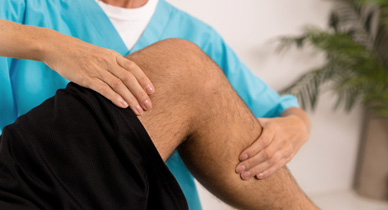New Delhi, Mar 23: For those suffering with age-related (degenerative) arthritis of the knee, a stage comes when all the reasonable non-operative options stops working. Here's when the option of surgery comes into the picture.
 Dr J Maheshwari, Director and Chief of Knee & Shoulder Service and Head, Max Smart Super Specialty Hospital, Saket said that one common option suggested is knee replacement, and it being as intimidating as it sounds, it is natural that patients look for an alternative. Other non operative options such as stem cell treatment, oil messages etc. with large claims and no scientific backing also come into consideration.
Dr J Maheshwari, Director and Chief of Knee & Shoulder Service and Head, Max Smart Super Specialty Hospital, Saket said that one common option suggested is knee replacement, and it being as intimidating as it sounds, it is natural that patients look for an alternative. Other non operative options such as stem cell treatment, oil messages etc. with large claims and no scientific backing also come into consideration.
Scared of the so called 'Total Knee Replacement', the patients often fall for alternative treatment modalities with tall claims and no scientific validity, and ultimately land up in a situation where knee replacement, like it or not, remains the only option.
Sometimes the surgery is delayed so much that even the best of surgeons cannot give a good result, and the fear of the patient actually 'comes true', said Dr Maheshwari.
There is a recent advance in medicine, where the scientific community is focusing on 'joint preservation' and not 'replacement' options. Some of these are non surgical - such as physiotherapy, weight reduction, modification in life-style etc, but others are surgical, where effort is to keep the original joint going. Some of these options may be surgical, aimed at corrective surgery in early stages of the arthritis, where one can see that if left to itself that particular joint is going to the path of damage, and hence future knee replacement.
These options could be key-hole surgery (arthroscopic surgery), which, if done at the right time, can halt the progress of the disease and may save one from knee replacement. Unfortunately, most patients do not have significant complaints at this stage, and may ignore their problem.
Dr Maheshwari further stated, in some patients with deformed legs (bow legs), the progress of arthritis can be halted by correcting the alignment, what is called high tibial osteotomy (HTO). Best approach, therefore would be to see a specialist to get yourself evaluated whether you have some such issue which may be the reason for your knee to take downhill course, and whether some intervention can prevent it from reaching knee replacement stage.
Even in cases, where joint is damaged beyond a certain level, it is not necessary that total replacement is the only option. There are options where only the damaged part of the knee is capped (partial replacement).
Knee, as we know it today, is made up of three distinct compartments. Often the damage is limited to only one of the three compartments, and in such cases, a limited surgery on that compartment can produce good results, without changing the whole joint. These operations are more recent in the armamentarium of knee surgeons, and have been shown to be effective. These options are not applicable in every patient of advanced knee arthritis, but in some, selected by careful investigations and special X rays. These are good joint preserving options.
As a last resort, knee replacement is always an option in case it is ascertained that all compartments of the knee are damaged. Also knee replacement remains a potent back up option in any case where partial replacement has been done in the past, and for some reason it has not given desired results.





Comments
Add new comment